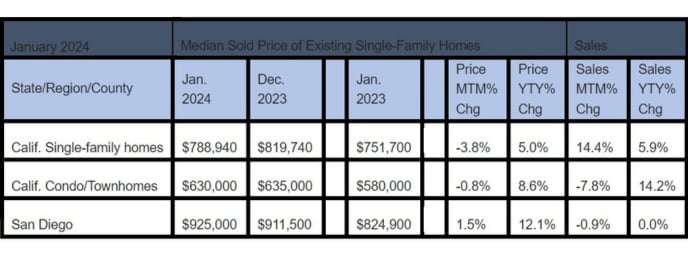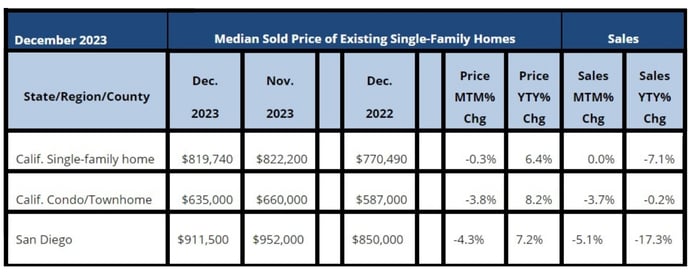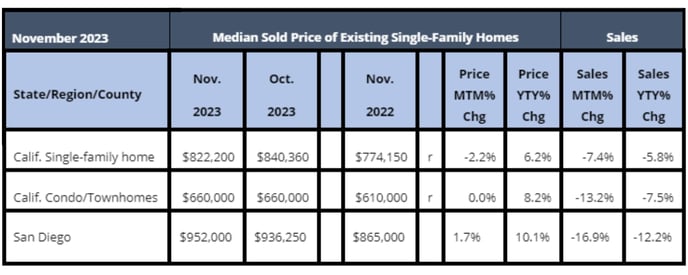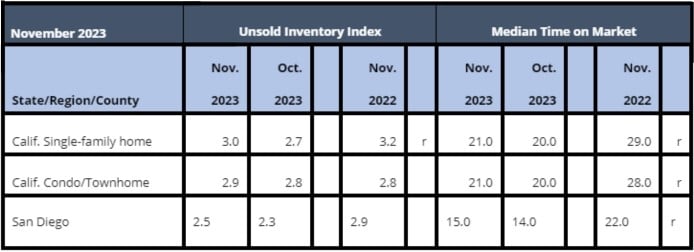
Despite a recent uptick in mortgage interest rates, California’s housing market continued to demonstrate resiliency in February 2024, reaching sales levels not seen since September 2022, according to the latest home sales and price report from the California Association of Realtors (C.A.R.).
In San Diego County, homes sales and home prices outpaced statewide levels with greater margins.
Sales of existing, single-family homes in San Diego County increased 20.9 percent in a month-over-month comparison between February 2024 and January 2024. In a year-over-year comparison between February 2024 and February 2023, the sales pace also was higher, an increase of 8.1 percent.
Similarly, statewide home sales for February 2024 increased 12.8 percent in a month-over-month comparison and 1.3 percent year-over-year. The monthly sales increase was the second straight month of double-digit gains for California. It was also the second consecutive month of year-over-year gains.
Closed escrow sales of existing, single-family detached homes in California totaled a seasonally adjusted annualized rate of 290,020 in February, according to information collected by C.A.R. from more than 90 local REALTOR® associations and MLSs statewide. The statewide annualized sales figure represents what would be the total number of homes sold during 2024 if sales maintained the February pace throughout the year. It is adjusted to account for seasonal factors that typically influence home sales.
The statewide sales pace remained below the 300,000 threshold for the 17th consecutive month. While it is likely that sales will stay below this level in the first quarter of 2024, statewide home sales on a year-to-date basis remained positive with an increase of 3.4 percent, suggesting a better spring home-buying season than that experienced last year.
Meanwhile, home prices continued to rise in San Diego County in February 2024.
The median sales price of an existing, single-family detached home in San Diego County in February 2024 was $980,000, a 5.9 percent difference from January 2024, when the median was $925,000. A year ago, in February 2023, the median price for a San Diego County home was $878,000, a difference of 11.6 percent with February 2024.
February 2023 County Sales and Price Activity
(Regional and condo sales data not seasonally adjusted)
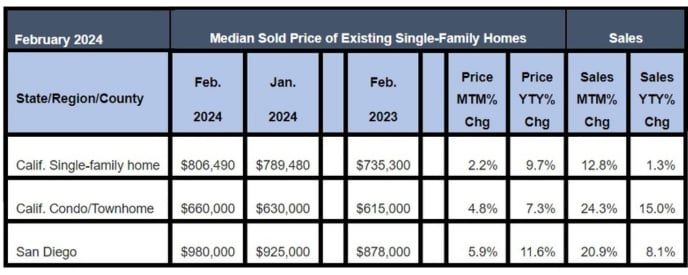
Home prices on a statewide basis also increased, but at smaller margins compared to San Diego. The median price of an existing, single-family home in California was $806,490 in February 2024, a 2.2 percent difference with the statewide median price of $789,480 in January 2024. A year ago, in February 2023, the statewide median home price was $735,300, a difference of 9.7 percent with February 2024.
The near-double-digit, year-over-year gain was the eighth straight month of annual price increases for the Golden State. It was the tenth time in the last 11 months that the median price for an existing single-family home was above $800,000.
With mortgage rates on the uptick since the start of the year and concerns about rates staying elevated for at least the first half of 2024, the housing market could struggle to build on the momentum exhibited in the first two months of this year. However, tight inventory conditions should keep the market highly competitive and provide support for prices.
Moreover, sales of homes priced at or above $1 million have been holding up better in the last few months than more affordable options. The high-end market segment continued to grow year-over-year in February by double digits, while the more affordable segment declined again modestly. The mix of sales toward higher priced homes continued to provide support to the statewide median price and was partly responsible for the strong surge year-over-year price growth rate in February.
“Housing supply conditions in California continued to improve in February with new active listings rising more than 10 percent for the second straight month,” said C.A.R. President Melanie Barker, a Yosemite REALTOR®. “This is great news for buyers who have been competing for a dearth of homes for sale, and the momentum will hopefully build further as we enter the spring home buying season.”
“Consumers have been feeling more positive about buying and selling since the beginning of the year, as increases in sales activity and home prices are reflected in the latest improvement in optimism,” said C.A.R. Senior Vice President and Chief Economist Jordan Levine. “While the recent upward movement in interest rates may result in more moderate sales in March, we expect homebuyers on the sidelines to reenter the market as the economy slows and rates begin to trend down again in the second quarter.”
Other key points from C.A.R.’s February 2024 resale housing report include:
- Home sales in all major regions in the state rose in February 2024, including 7.0 percent in Southern California.
- At the regional level, home prices increased in February 2024 in all major reasons compared to a year ago, including 10.8 percent in Southern California.
- The unsold inventory statewide index decreased 6.3 percent in February 2024 on a month-over-month basis, dipping by 3.2 percent from February 2023. The index, which measures the number of months needed to sell the supply of homes on the market at the current sales rate, dipped from 3.2 months in January 2024 to 3.0 months in February 2024. The index was 3.1 months in February 2023.
February 2023 County Unsold Inventory and Days on Market
(Regional and condo sales data not seasonally adjusted)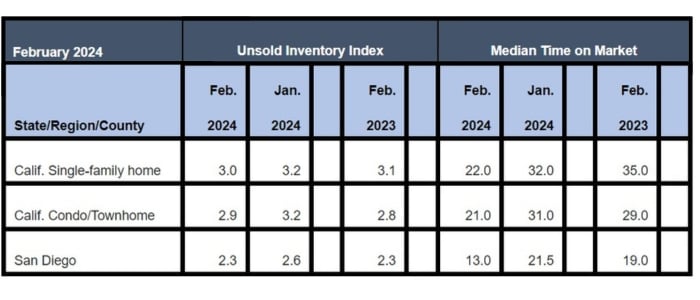
- The unsold inventory index of available existing homes for sales in February 2024 in San Diego County was 2.3 months, a figure that was identical to February 2023. The index was 2.6 months in January 2024. Inventory levels indicate the number of months it would take for the available supply of homes on the market to sell-out given the current rate of sales.
- Existing active listings at the state level increased on a year-over year basis for the first time in 11 months. February’s increase was the largest in 12 months, an encouraging sign that housing supply could be heading in the right direction as the market approaches the spring home-buying season. However, mortgage rates have increased since the start of the year and are expected to remain elevated, which may cause potential sellers to have second thoughts about listing their house for sale.
- New active listings in February 2024 at the state level increased from a year ago for the second consecutive month by double digits as more sellers listed their homes on the market ahead of the spring home buying season as mortgage rates dipped at the start of the year. The annual listings increase was the largest since May 2022.
- The median number of days it took to sell a California single-family home was 22 days in February 2024, 32 days in January 2024 and 35 days in February 2023.
- In San Diego, the median number of days it took to sell an existing, single-family home was 13 days in February 2024, 21.5 days in January 2024 and 19 days in February 2023. The median represents the time when half the homes sell above it and half below it.
- C.A.R.’s statewide sales-price-to-list-price ratio was 100 percent in February 2024, 98.9 percent in January 2024 and 97.7 percent in February 2023. In 2023, the statewide, sales-price-to-list-price ratio on a monthly basis was at 99 percent in December, 100 percent in November, October, September, August, July, June, May and April, 99.1 percent in March, 97.7 percent in February and 96.5 percent in January.
- The 30-year, fixed-mortgage interest rate averaged 6.78 percent in February, up from 6.26 percent in February 2023, according to C.A.R.’s calculations based on Freddie Mac’s weekly mortgage survey data.





